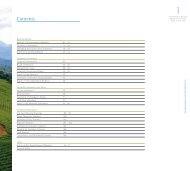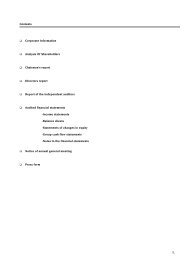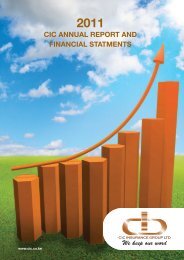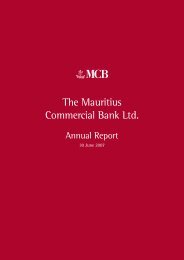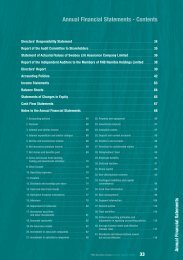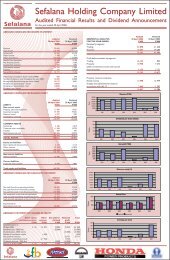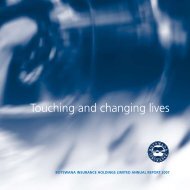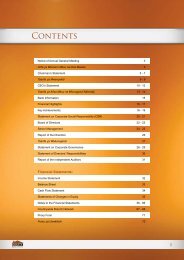Annual Report 2007 - Investing In Africa
Annual Report 2007 - Investing In Africa
Annual Report 2007 - Investing In Africa
You also want an ePaper? Increase the reach of your titles
YUMPU automatically turns print PDFs into web optimized ePapers that Google loves.
2.10 Sale and Repurchase Agreement<br />
Securities sold subject to repurchase agreements<br />
(‘repos’) are reclassified in the financial statements<br />
as pledged assets when the transferee has the<br />
right by contract or custom to sell or repledge the<br />
collateral; the counterparty liability is included in<br />
amounts due to other banks, deposits from banks,<br />
other deposits or deposits due to customers, as<br />
appropriate. Securities purchased under agreements<br />
to resell (‘reverse repos’) are recorded as<br />
loans and advances to other banks or customers,<br />
as appropriate. The difference between sale and<br />
repurchase price is treated as interest and accrued<br />
over the life of the agreements using the effective<br />
interest method. Securities lent to counterparties<br />
are also retained in the financial statements.<br />
2.11 Derivative Financial <strong>In</strong>struments<br />
Derivatives, which comprise forward foreign<br />
exchange contracts and interest rate swaps are<br />
initially recognised at fair value on the date the<br />
derivative contract is entered into and are<br />
subsequently measured at fair value. The fair<br />
value is determined using recent transactions,<br />
forward exchange market rates at the balance<br />
sheet date or appropriate pricing models. The<br />
derivatives do not qualify for hedge accounting.<br />
Changes in the fair value of derivatives are recognised<br />
immediately in the profit and loss<br />
account.<br />
2.12 Impairment of Financial Assets<br />
a) Assets carried at amortised cost<br />
The group assesses at each balance sheet date<br />
whether there is objective evidence that a<br />
financial asset or group of financial assets is<br />
impaired. A financial asset or a group of financial<br />
assets is impaired and impairment losses are<br />
incurred only if there is objective evidence of<br />
impairment as a result of one or more events<br />
that occurred after the initial recognition of the<br />
asset (a ‘loss event’) and that loss event (or<br />
events) has an impact on the estimated future<br />
cash flows of the financial asset or group of<br />
financial assets that can be reliably estimated.<br />
The criteria that the group uses to determine<br />
that there is objective evidence of an impairment<br />
loss include:<br />
Delinquency in contractual payments of<br />
principal or interest;<br />
Cash flow difficulties experienced by the<br />
borrower (for example, equity ratio, net<br />
income percentage of sales);<br />
Breach of loan covenants or conditions;<br />
<strong>In</strong>itiation of legal proceedings to enforce<br />
security;<br />
Deterioration of the borrower’s competitive<br />
position;<br />
Deterioration in the value of collateral; and<br />
Downgrading below investment grade level.<br />
The estimated period between a loss occurring<br />
and its identification is determined by local<br />
management for each identified portfolio. <strong>In</strong><br />
general, the periods used vary between three<br />
months and 12 months; in exceptional cases,<br />
longer periods are warranted.<br />
The group first assesses whether objective evidence<br />
of impairment exists individually for<br />
financial assets that are individually significant,<br />
and individually or collectively for financial<br />
assets that are not individually significant. If the<br />
group determines that no objective evidence of<br />
impairment exists for an individually assessed<br />
financial asset, whether significant or not, it<br />
includes the asset in a group of financial assets<br />
with similar credit risk characteristics and collectively<br />
assesses them for impairment. Assets that<br />
are individually assessed for impairment and for<br />
which an impairment loss is or continues to be<br />
recognised are not included in a collective<br />
assessment of impairment.<br />
63<br />
... The Pan <strong>Africa</strong>n Bank




